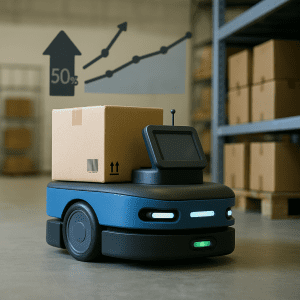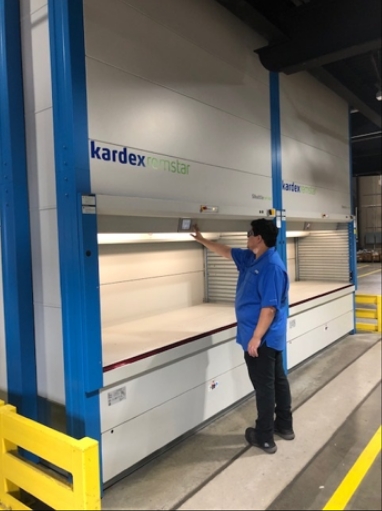Autonomous Mobile Robots (AMRs) are revolutionizing warehouse operations. These intelligent machines are reshaping how goods are stored, retrieved, and managed in modern distribution centers.
At Vertical Storage USA, we’ve seen firsthand how AMR warehouse solutions can boost efficiency and cut costs. This guide will equip managers with essential knowledge about AMR technology, its benefits, and implementation challenges.
What Are AMRs and How Do They Work?

Autonomous Mobile Robots (AMRs) transform warehouse operations with their intelligent, independent navigation. These machines use sensors and machine vision to navigate space and perform tasks without predefined routes or instructions. They perceive and interact with their environment in real-time.
The navigation technology forms the heart of an AMR system. Most AMRs utilize a combination of LiDAR (Light Detection and Ranging) sensors, cameras, and sometimes ultrasonic sensors. This sensor array creates a detailed map of the surroundings, enabling obstacle detection, route planning, and collision avoidance.
An onboard computer serves as the AMR’s brain, processing sensor data and making decisions based on complex algorithms. This computer also communicates with the warehouse management system (WMS) to receive instructions and report task completion.
AMRs vs Traditional Automation
AMRs offer significant advantages over traditional automated guided vehicles (AGVs). While AGVs follow fixed paths marked by magnetic strips or wires, AMRs dynamically plan their routes. This flexibility allows AMRs to adapt to changing warehouse layouts and avoid obstacles on the fly.
The global market for AMRs reflects this superiority. According to Global Market Insights, the global autonomous mobile robots market size was valued at USD 2.8 billion in 2024 and is estimated to grow at 17.6% CAGR from 2025 to 2034.
Navigation and Interaction in Warehouse Environments
AMRs employ simultaneous localization and mapping (SLAM) technology for navigation. This advanced system allows robots and other autonomous vehicles to build a map and localize themselves within that environment.
To interact with their environment, AMRs can be equipped with various attachments. Some storeroom AMRs are dedicated to order picking and feature robotic arms for precise item handling, while others incorporate conveyor belts for goods transport.. These attachments (customized for specific tasks) enhance the versatility and utility of AMRs in diverse warehouse settings.
Integration with Existing Systems
AMRs excel at complementing existing warehouse automation solutions. By keeping goods moving seamlessly between work zones, they improve overall material flow and reduce idle time across picking and storage areas. For instance, when integrated with Vertical Lift Modules and horizontal carousels (like those offered by Vertical Storage USA), AMRs significantly enhance the efficiency of goods-to-person operations.
As we move forward, let’s explore the tangible benefits that AMR implementation brings to warehouse operations. From increased efficiency to improved safety, the advantages of these intelligent robots extend far beyond simple automation.
How AMRs Transform Warehouse Operations

Autonomous Mobile Robots (AMRs) revolutionize warehouse efficiency by automating repetitive tasks and enhancing overall productivity and operational safety. AMR sales in the logistics industry have skyrocketed as the technology has evolved beyond two-dimensional lidar to three-dimensional visual autonomy.
A major e-commerce retailer experienced a 50% reduction in order processing time after implementing AMRs in their fulfillment centers. This improvement allowed them to meet same-day delivery promises more consistently, enhancing customer satisfaction.
Labor Cost Reduction and Safety Enhancement
AMR implementation leads to substantial labor cost savings. Average peak warehouse space utilization fell from 78.5% last year to 73.2% in 2024. This reduction often results in the reallocation of human workers to higher-value tasks that require complex decision-making and problem-solving skills.
Safety improvements are another significant benefit of AMR adoption. The U.S. Bureau of Labor Statistics reports that the warehousing and storage industry has an injury rate nearly twice the national average for all industries. AMRs take on physically demanding and potentially dangerous tasks, which significantly reduces the risk of workplace injuries. A logistics company reported a 73% decrease in workplace accidents after introducing AMRs for heavy lifting and transportation tasks.
Inventory Management Revolution
AMRs equipped with advanced sensors and RFID technology enable real-time inventory tracking and management. This capability drastically reduces inventory discrepancies and stockouts. Rising operating costs are key motivating factors for improving warehouse operations, according to an Aberdeen Group study.
Real-time data collection by AMRs also provides valuable insights for demand forecasting and inventory optimization. A food distribution company leveraging AMR-collected data reported a 20% reduction in carrying costs due to more accurate demand predictions and optimized stock levels.
Business Fluctuation Adaptation
The scalability and flexibility of AMR systems allow warehouses to adapt quickly to changing business needs. During peak seasons, additional AMRs can be easily deployed to handle increased workload without extensive training or infrastructure changes. This scalability proves particularly valuable in industries with seasonal demand fluctuations (such as retail and e-commerce).
A fashion retailer using AMRs reported a 40% increase in order fulfillment capacity during their busiest season without requiring additional warehouse space or significant staff increases. This flexibility allowed them to maintain high service levels despite dramatic demand spikes.
Integration with Existing Systems
AMRs excel at complementing existing warehouse automation solutions. When integrated with Vertical Lift Modules and horizontal carousels (like those offered by Vertical Storage USA), AMRs significantly enhance the efficiency of goods-to-person operations. This synergy between AMRs and other automated systems creates a powerful, flexible warehouse ecosystem.
The transformative impact of AMRs on warehouse operations is clear. However, successful implementation requires careful planning and consideration of potential challenges. The next section will explore key factors warehouse managers should consider when adopting AMR technology.
Navigating AMR Implementation Challenges
The upfront cost of AMR systems can be substantial. A single AMR unit can range from $10,000 to $100,000, depending on its capabilities. However, focusing solely on this figure misses the bigger picture. The true value lies in long-term savings and efficiency gains.
To accurately calculate ROI, managers must factor in labor cost reductions, increased throughput, and improved accuracy. A comprehensive analysis of specific operations is essential. Managers should consider factors like peak season demands, current inefficiencies, and projected growth. This detailed approach will provide a more accurate picture of potential returns.
Integration with Existing Systems
One of the most significant hurdles in AMR implementation is integration with existing Warehouse Management Systems (WMS). Compatibility issues can lead to disruptions and inefficiencies if not addressed properly.
A thorough audit of current WMS capabilities is essential. Some older systems may require upgrades or even replacement to fully leverage AMR technology. Technological integration brings numerous benefits, including dynamic performance improvements, seamless software updates, and real-time data processing.
IT teams should be involved early in the process. Their insights can help identify potential bottlenecks and ensure smooth data flow between AMRs and the WMS. Additionally, managers should consider working with AMR providers that offer robust integration support and have experience with specific WMS platforms.
Addressing Employee Concerns
Employee resistance to new technology can significantly hinder AMR implementation. Clear communication and comprehensive training are vital to overcome this challenge.
Managers should involve key stakeholders from various departments in the planning process. This inclusivity helps address concerns early and builds buy-in across the organization. Success rates improve when companies adopt this collaborative approach.
A structured training program that goes beyond basic AMR operation is essential. Modules should include troubleshooting, safety protocols, and how AMRs fit into the broader warehouse strategy.
It’s also important to address job security concerns directly. Managers should emphasize how AMRs will enhance (not replace) human roles. Opportunities for upskilling and new positions that may arise from AMR adoption should be highlighted.
Maintenance and Support Requirements
Regular maintenance is critical for optimal AMR performance. Managers must factor in ongoing costs for software updates, hardware replacements, and technical support.
Establishing a dedicated maintenance team or partnering with a reliable service provider is recommended. This ensures quick resolution of issues and minimizes downtime. Companies that implement proactive maintenance schedules report up to 30% fewer AMR-related disruptions.
Managers should also consider the availability of spare parts and the ease of repairs. Some AMR manufacturers offer modular designs that simplify maintenance and reduce repair times.
Final Thoughts
AMR warehouse technology transforms logistics operations with unparalleled efficiency and flexibility. These intelligent machines navigate complex environments, perform tasks with precision, and integrate seamlessly with existing systems. AMRs increase productivity, reduce labor costs, enhance safety, and improve inventory management in warehouses.
The future of AMR technology promises enhanced AI-driven decision-making and improved human-robot collaboration. Managers who consider AMR adoption should assess their current operations, identify pain points, and define clear objectives. A thorough cost-benefit analysis will help determine the potential impact of AMRs on warehouse processes. Storeroom AMRs continue to evolve, offering smarter navigation, improved material flow, and enhancing overall performance across facilities of all sizes.
Vertical Storage USA specializes in cutting-edge warehouse automation solutions, including AMR systems. Our expertise in various robotic systems complements AMR technology, creating a powerful ecosystem for warehouse optimization. We can help you navigate the complexities of AMR implementation and ensure smooth integration with your existing infrastructure.





